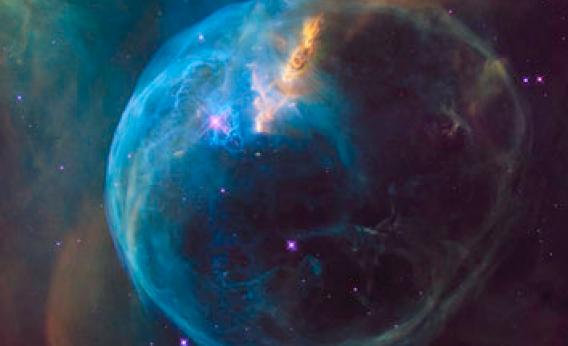Create a free profile to get unlimited access to exclusive videos, sweepstakes, and more!
A Seriously MASSIVE Bubble Blown in Space Celebrates Hubble’s 26th
Anniversary

On April 24, 1990, the Hubble Space Telescope was lofted into orbit onboard the Space Shuttle Discovery. Sunday is the 26th anniversary of this grand event, and to celebrate, the good folks at the Space Telescope Science Institute have created a new and simply spectacular image.
Get a load of this!
That is the Bubble Nebula, aka NGC 7635. It looks almost delicate, doesn’t it? Like a thin soap bubble floating in space.
But that's a lie. Nothing about this tremendous beast is delicate.
What you’re seeing is the gas blowing outward from a massive star. Called SAO 20575, it’s the brightest star in the image, near the left edge of the bubble. And by massive, I mean somewhere between 10 and 40 times the mass of the Sun, so it’s a real bruiser. It’s already used up all the hydrogen in its core and is fusing heavier elements to generate energy. The vast amounts of energy generated in the core when this happens heats the outer layers so much that they get blown away from the star, forming the nebula.
The star is incredibly bright; it emits something like 400,000 times as much energy as the Sun does! If you replaced the Sun with SAO 20575, we’d have about one second before regretting that decision. The Earth would be cooked. Good thing SAO 20575 is 8,000 light-years away.
Because the wind is so fiercely powerful, the nebula itself is huge. When a star like the Sun dies and blows a similar (but far less energetic) wind, the nebula it makes might be one or two light-years across. Because the distance isn't well constrained, the exact size of the Bubble Nebula isn't well known, but measured from Hubble images it's something like five to eight light-years in diameter. That’s 50–80 trillion kilometers across! Put simply, that’s ridiculously big.
The Bubble really is a bubble, too: The wind blows away in a sphere, but winds up being bright around the edge because of an effect called edge brightening; when we look at the nebula, we see more material near the edge than when looking through the middle, making the edge look brighter. This can be reinforced if the nebula is expanding into gas that was previously outside the star; the material gets snowplowed up, adding its own brightness to the nebula’s.
You may have noticed the star blowing the bubble is way off-center, far to the left. That can happen if the star is moving rapidly in space, so fast it moves away from the center of the nebula it blew. The star’s motion has been measured and is in the right direction to account for this.
There’s also another possibility. The interstellar material surrounding the bubble is pretty thick; massive stars don’t live long and don’t usually get very far from the cloud of dust and gas from which they were born. The star is so bright that its ultraviolet light is evaporating that material, which is thickest to the upper left as seen in this image. That created a density gradient in the gas, a change in its density from one side to the other. If that’s the case, than the wind from the star can expand more easily in the direction away from the denser gas, making the bubble off-center from the star.
If that’s the case the Bubble may not actually be spherical; we just happen to see it looking down its elongated axis (that’s the case for the famous Ring Nebula, which looks round but is actually more barrel-shaped).
There is still some uncertainty about how this object was sculpted in this way. We’re still learning about it. The Bubble was observed before by Hubble, in 1998 and in 1999, the best images ever taken at the time, and you can see how much clearer our view is now.
And I can’t think of a more fitting tribute to Hubble itself. Launched more than a quarter century ago, it’s opened up so much of the sky to us, and brought the beauty of the heavens to humanity in a way never done before. Over time it’s been upgraded, with new and more powerful cameras installed, sharpening our view and our understanding of the cosmos.
And it’s not done yet. There’s still so much to see, so much to learn. Hubble has brought us a long way, but—happily—this is a journey that never ends.


























